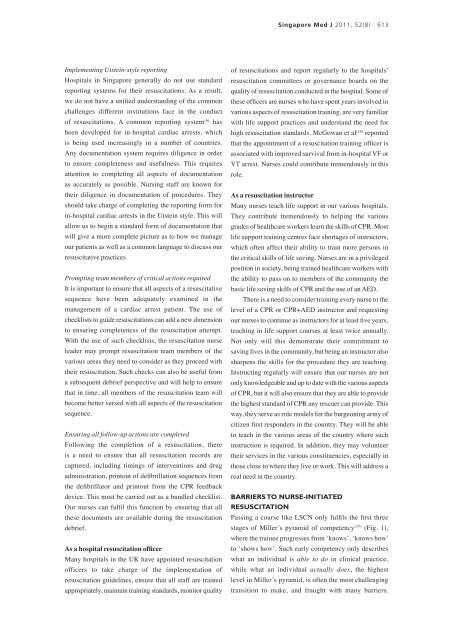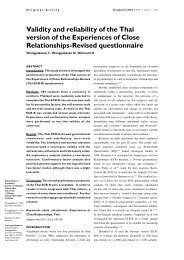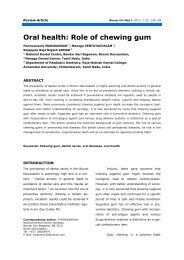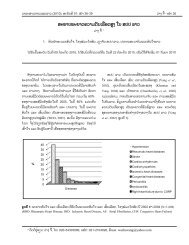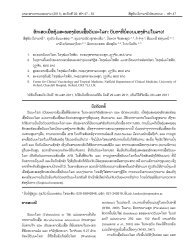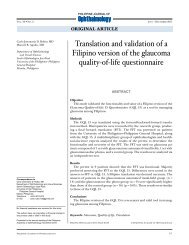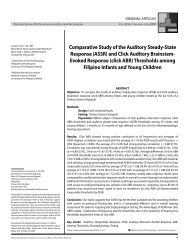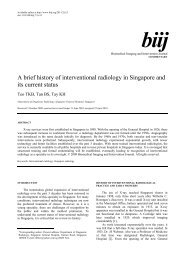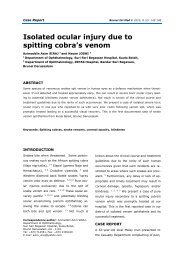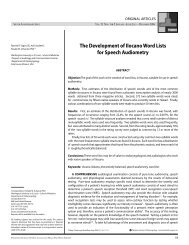PDF ( B) - APAMED Central
PDF ( B) - APAMED Central
PDF ( B) - APAMED Central
You also want an ePaper? Increase the reach of your titles
YUMPU automatically turns print PDFs into web optimized ePapers that Google loves.
Singapore Med J 2011; 52(8) : 613<br />
Implementing Utstein-style reporting<br />
Hospitals in Singapore generally do not use standard<br />
reporting systems for their resuscitations. As a result,<br />
we do not have a unified understanding of the common<br />
challenges different institutions face in the conduct<br />
of resuscitations. A common reporting system (6) has<br />
been developed for in-hospital cardiac arrests, which<br />
is being used increasingly in a number of countries.<br />
Any documentation system requires diligence in order<br />
to ensure completeness and usefulness. This requires<br />
attention to completing all aspects of documentation<br />
as accurately as possible. Nursing staff are known for<br />
their diligence in documentation of procedures. They<br />
should take charge of completing the reporting form for<br />
in-hospital cardiac arrests in the Utstein style. This will<br />
allow us to begin a standard form of documentation that<br />
will give a more complete picture as to how we manage<br />
our patients as well as a common language to discuss our<br />
resuscitative practices.<br />
Prompting team members of critical actions required<br />
It is important to ensure that all aspects of a resuscitative<br />
sequence have been adequately examined in the<br />
management of a cardiac arrest patient. The use of<br />
checklists to guide resuscitations can add a new dimension<br />
to ensuring completeness of the resuscitation attempt.<br />
With the use of such checklists, the resuscitation nurse<br />
leader may prompt resuscitation team members of the<br />
various areas they need to consider as they proceed with<br />
their resuscitation. Such checks can also be useful from<br />
a subsequent debrief perspective and will help to ensure<br />
that in time, all members of the resuscitation team will<br />
become better versed with all aspects of the resuscitation<br />
sequence.<br />
Ensuring all follow-up actions are completed<br />
Following the completion of a resuscitation, there<br />
is a need to ensure that all resuscitation records are<br />
captured, including timings of interventions and drug<br />
administration, printout of defibrillation sequences from<br />
the defibrillator and printout from the CPR feedback<br />
device. This must be carried out as a bundled checklist.<br />
Our nurses can fulfil this function by ensuring that all<br />
these documents are available during the resuscitation<br />
debrief.<br />
As a hospital resuscitation officer<br />
Many hospitals in the UK have appointed resuscitation<br />
officers to take charge of the implementation of<br />
resuscitation guidelines, ensure that all staff are trained<br />
appropriately, maintain training standards, monitor quality<br />
of resuscitations and report regularly to the hospitals’<br />
resuscitation committees or governance boards on the<br />
quality of resuscitation conducted in the hospital. Some of<br />
these officers are nurses who have spent years involved in<br />
various aspects of resuscitation training, are very familiar<br />
with life support practices and understand the need for<br />
high resuscitation standards. McGowan et al (16) reported<br />
that the appointment of a resuscitation training officer is<br />
associated with improved survival from in-hospital VF or<br />
VT arrest. Nurses could contribute tremendously in this<br />
role.<br />
As a resuscitation instructor<br />
Many nurses teach life support in our various hospitals.<br />
They contribute tremendously to helping the various<br />
grades of healthcare workers learn the skills of CPR. Most<br />
life support training centres face shortages of instructors,<br />
which often affect their ability to train more persons in<br />
the critical skills of life saving. Nurses are in a privileged<br />
position in society, being trained healthcare workers with<br />
the ability to pass on to members of the community the<br />
basic life saving skills of CPR and the use of an AED.<br />
There is a need to consider training every nurse to the<br />
level of a CPR or CPR+AED instructor and requesting<br />
our nurses to continue as instructors for at least five years,<br />
teaching in life support courses at least twice annually.<br />
Not only will this demonstrate their commitment to<br />
saving lives in the community, but being an instructor also<br />
sharpens the skills for the procedure they are teaching.<br />
Instructing regularly will ensure that our nurses are not<br />
only knowledgeable and up to date with the various aspects<br />
of CPR, but it will also ensure that they are able to provide<br />
the highest standard of CPR any rescuer can provide. This<br />
way, they serve as role models for the burgeoning army of<br />
citizen first responders in the country. They will be able<br />
to teach in the various areas of the country where such<br />
instruction is required. In addition, they may volunteer<br />
their services in the various constituencies, especially in<br />
those close to where they live or work. This will address a<br />
real need in the country.<br />
BARRIERS TO NURSE-INITIATED<br />
RESUSCITATION<br />
Passing a course like LSCN only fulfils the first three<br />
stages of Miller’s pyramid of competency (17) (Fig. 1),<br />
where the trainee progresses from ‘knows’, ‘knows how’<br />
to ‘shows how’. Such early competency only describes<br />
what an individual is able to do in clinical practice,<br />
while what an individual actually does, the highest<br />
level in Miller’s pyramid, is often the most challenging<br />
transition to make, and fraught with many barriers.


